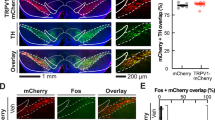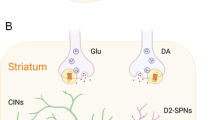Abstract
A LARGE body of evidence exists to support the hypothesis that most antipsychotic drugs exert their specific actions by antagonising the effects of dopamine at postsynaptic receptors within the central nervous system1–3. More recent evidence suggests that postsynaptic dopamine receptors may occur not only at sites of axon terminals, but also within the region of the cell bodies which give rise to the ascending dopaminergic projections. Iontophoretic application of dopamine to dopamine-containing neurone cell bodies in the zona compacta of the substantia nigra, inhibits firing of these cells4. Fluorescent histochemical examination of the substantia nigra with the glyoxylic acid technique has shown that dendrites arising from cell bodies of the zona compacta contain intensely fluorescent varicosities, and that these occur both in compacta and reticulata regions of the substantia nigra5. These varicosities may form the anatomical basis for a mechanism of self-inhibition whereby dopamine released from dendritic varicosities on stimulation subsequently inhibits the firing of the dopamine neurones themselves6. Direct support for the role of dendrites in the release of dopamine has been obtained by showing that slices of substantia nigra labelled by exposure to 3H-dopamine will release labelled dopamine when depolarised by high potassium concentrations7. We set out to explore further the hypothesis of self-inhibitory control by looking for biochemical evidence of a dopamine response in this region of the brain. Homogenates of tissues containing dopaminergic axon terminals respond to low concentrations of dopamine by increased production of cyclic AMP8–12. We now provide evidence that a similar dopamine sensitive adenylate cyclase is present in the rat substantia nigra, and that it is potently antagonised by antipsychotic drugs.
This is a preview of subscription content, access via your institution
Access options
Subscribe to this journal
Receive 51 print issues and online access
$199.00 per year
only $3.90 per issue
Buy this article
- Purchase on SpringerLink
- Instant access to full article PDF
Prices may be subject to local taxes which are calculated during checkout
Similar content being viewed by others
References
Matthysse, S., Fedn Proc., 32, 200–205 (1972).
Snyder, S. H., Archs gen. Psychiat., 27, 169–179 (1972).
Iversen, L. L., Science, 188, 1084–1089 (1975).
Aghajanian, G. K., and Bunney, B. S., Frontiers in Catecholamine Research, 643–648 (Pergamon, Oxford, 1973).
Björklund, A., and Lindvall, Olle, Brain Res., 83, 531–537 (1975).
Groves, P. M., Wilson, C. J., Young, S. J., and Rebec, G. V., Science, 190, 522–529 (1975).
Geffen, L. B., Jessell, T. M., Cuello, A. C., and Iversen, L. L., Nature, 260, 258–260 (1976).
Greengard, P., McAfee, D. A., and Kebabian, S. W., in Advances in Cyclic Nucleotide Research, 5, 337–357 (Raven, New York, 1972).
Brown, J. H., and Makman, M. H., Proc. natn. Acad. Sci. U.S.A., 69, 539–543 (1972).
Kebabian, J. W., Petzold, G. L., and Greengard, P., Proc. natn. Acad. Sci. U.S.A., 69, 2145–2149 (1972).
Horn, A. S., Cuello, A. C., and Miller, R. J., J. Neurochem., 22, 265–270 (1974).
Von Hungen, H., and Roberts, S., Eur. J. Biochem., 36, 391–401 (1973).
Miller, R., Horn, A., Iversen, L., and Pinder, R., Nature, 250, 238–241 (1974).
Klein, D. F., and Davis, J. M., Diagnosis and Drug Treatment of Psychiatric Disorders (Williams and Wilkins, Baltimore, 1969).
Møller-Nielsen, I., et al., Acta pharmac. tox., 33, 353–362 (1973).
Miller, R. J., Horn, A. S., and Iversen, L. L., Mol. Pharmac., 10, 757–766 (1974).
Clement-Cormier, Y. C., Kebabian, J. W., Petzold, G. L., and Greengard, P., Proc. natn. Acad. Sci. U.S.A., 71, 1113–1117 (1974).
Konig, J. F. R., and Klippel, R. A., The Rat Brain (Kriefer, New York, 1967).
Ungerstedt, U., Acta physiol. scand. Suppl., 367, 1–47 (1971).
Ben-Ari, Y., and Zigmond, R. E., J. Physiol. Lond., 251, 4P–5P (1975).
Brown, B. L., Ekins, R. D., and Albano, J. D. M., in Advances in Cyclic Nucleotide Research, 2 (edit. by Greengard, P., and Robinson, G. A.), 25–40 (Raven, New York, 1972).
York, D. H., in Handbook of Psychopharmacology, 6 (edit. by Iversen, L. L., Iversen, S. D., and Synder, S. H.), 23–61 (Plenum, New York, 1975).
Okada, Y., Nitsch-Hassler, C., Kim, J. S., Bak, I. J., and Hassler, R., Expl Brain Res., 13, 514–518 (1971).
Duffy, M. S., Wong, J., and Powell, D., Neuropharmacology, 14, 615–618 (1975).
Author information
Authors and Affiliations
Rights and permissions
About this article
Cite this article
PHILLIPSON, O., HORN, A. Substantia nigra of the rat contains a dopamine sensitive adenylate cyclase. Nature 261, 418–420 (1976). https://doi.org/10.1038/261418a0
Received:
Accepted:
Issue date:
DOI: https://doi.org/10.1038/261418a0
This article is cited by
-
Multiple dopamine receptors: fact, fiction or confusion?
Pharmaceutisch weekblad (1981)
-
Multiple receptors for dopamine
Nature (1979)
-
Absence of dopamine sensitive adenylate cyclase in the A10 region, the origin of mesolimbic dopamine neurones
Experientia (1979)
-
A new dopaminergic prodrug
Nature (1978)
-
d-Amphetamine-induced depression of central dopamine neurons: Evidence for mediation by both autoreceptors and a striato-nigral feedback pathway
Naunyn-Schmiedeberg's Archives of Pharmacology (1978)



